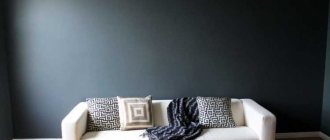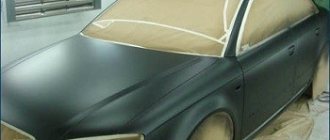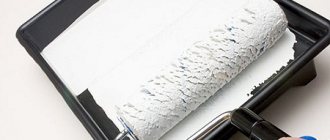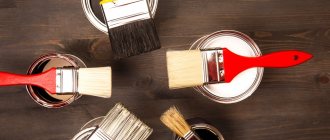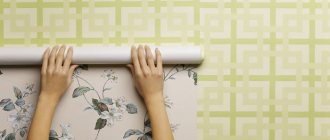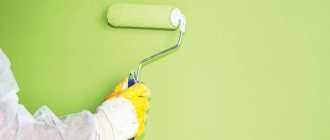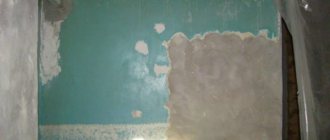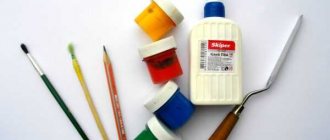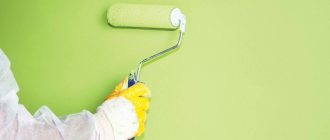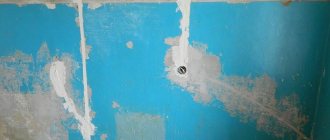It happens that glossy paint products do not always fit well into the interior of the room.
If the windows of your room face the sunny side, then the glare reflected from the glossy wall will only irritate the eyes.
Matte paint and varnish material is intended just for such cases.
If you only have glossy paint in your arsenal, this does not mean that you need to immediately run headlong to the store for matte paint.
Still, there are many ways to matte glossy paint yourself.
Glare on the surface - how to avoid it
Read also: How to make a glacier cellar with your own hands
Often, a matte finish is optimal for rooms that are exposed to the sun.
Experts give some tips on how you can limit yourself from glare.
Mechanical method - how it works
Mother of pearl for cars
Preparation of mother-of-pearl paint for a car is carried out from finely dispersed black mother-of-pearl
, gum arabic - black resin, colored ink and mother-of-pearl. Small jars are pre-prepared into which the mixture will later be poured. Take 5 parts of mother of pearl and one part of gum arabic. These components are mixed until a homogeneous paste form is obtained.
You can get mother of pearl at home from fish.
The fish scales are placed in a jar and filled with water. After this, take a mixer and beat the composition. This will cause the pearlescent film to separate into small crystals. After this, the scales are removed and the resulting sediment is dried. It must be added to paint to obtain a pearlescent tint.
ATTENTION!
Read also: Do-it-yourself clamps for gluing
Pearlescent pigment is obtained from guanine, which is found in fish scales.
Design
Thanks to matte and glossy surfaces and their combinations, you can create different types of designs to suit the individual style of your space.
- In multi-level structures, glossy surfaces are more often used, as they enliven the ceiling.
- For a classic style, it is better to use a matte surface.
- Glossy films have a huge palette of colors compared to matte ones.
- But at the same time, matte coatings are able to absorb any reflections and reflections, and also retain their original color for a long time.
Overview of paints
Gloss levels
When talking about such compounds, we often lose sight of the fact that they can belong to different categories. And here it is very important to make the right choice, since depending on the characteristics of the coating, not only aesthetic characteristics, but also durability differ.
Application of matte composition
Most often, paints are divided into the following groups:
- Matte (marked “matt”) . Such coatings have virtually no shine, which allows them to be used to effectively mask various surface defects. The main disadvantage is the rather high porosity of the surface, which leads to rapid contamination and complicates cleaning.
Note! Many technological compositions, such as fire-retardant paints for metal Polistil, have a matte texture.
- " Egg shell" Such paints are superior to matte in terms of wear resistance, are easier to clean and are less dirty. In this case, the surface shines only when illuminated from a certain angle, which must be taken into account when developing the design.
- Semi-matte or satin (“satin”) . The treated surface has a pleasant shine, but at the same time has a clearly defined texture. Such paints are widely used when working on wood, as well as in interior decoration – where the surface is subject to operational loads.
Latex water-based paints
Styrene-butadiene paint is a pigment suspension in an emulsion of a styrene-butadiene polymer component. The mixture also includes stabilizers, emulsifiers and some other substances.
Paints are produced in paste form. Before use, the butadiene-styrene mixture must be diluted with water. Moreover, you will need soft water, since contact with hard water may cause the mixture to coagulate. Paintwork materials are applied to a putty and primed surface, although you can do without pre-treating the surface with these compounds. This type of paintwork material goes well with old coatings painted with oil paint. After painting, the surface acquires a matte or slightly glossy appearance.
Unlike PVA, styrene-butadiene paints are much more resistant to moisture. In addition, they have better wear resistance and washability.
Compared to polyvinyl acetate compositions, latex water-based paints are not as durable and, moreover, inferior to them in terms of visual appeal. It is also worth noting the low resistance to light of this type of paintwork material. Under the influence of ultraviolet radiation, styrene-butadiene compounds lose their original appearance. Therefore, the best area for application of these paints and varnishes is interior surfaces. Although it should be noted that there are also universal latex water-based solutions on the market, which, thanks to the additives they contain, are suitable for treating facades.
Methods for applying this type of paint and varnish have their own characteristics. Particularly good results are obtained by painting with rollers - in this case, the viscosity indicator should be from 45 to 50 seconds according to VZ-4. If the paint is applied with a spray gun, the viscosity level is allowed within 30-33 seconds. But painting with a brush is not recommended, since in this case prolonged shading is required, which is unacceptable for this type of paintwork material. Apply the composition in two or three layers.
For tattoo
Tattoo ink is an expensive material.
That is why it is often prepared at home. To do this, you need to take a tin can, put a lit piece of rubber in it and cover it with a plate. Soot will collect on the plate. It is collected in a container and diluted with the urine of the person who will be tattooed. IMPORTANT!
For a temporary tattoo, you can prepare paint based on henna powder.
Take 0.5 liters of water and heat it up. 40 grams of henna are added to the composition and boiled. After this, a few tablespoons of sugar are added to the mixture. Next, 10 milliliters of freshly squeezed lemon juice is added to the mixture, mixed and quickly removed from the heat. After cooling, the paint can be used for tattooing.
Can I spray varnish over acrylic paint?
Varnish is a hard, protective, removable coating applied to the surface to be painted. There are two types of varnish that can be used for acrylic painting: Mineral alcohol based (MSA)
“You can use this over everything, but it’s important that you have good ventilation.” ... Polymer varnish is not intended for painting.
Interesting materials:
Is Windows File History Good? When should you wash your windows? Does Windows Defender conflict with Kaspersky? What time is the woman at the window? Is Linux more secure than Windows 10? Is a MacBook faster than a Windows laptop? Do I really need Java on Windows 10? Can I upgrade to Windows 10 from XP for free without a CD? Can I play FEAR on Windows 10? Can I use Windows Ink without a touch screen?
Procedure and required materials
- Your gloss paint;
- Acrylic lacquer;
- Matting components.
No matter how strange it may sound, the magical transformation begins with painting the walls with the paint that is available. Just when the painting is completed and the walls have dried a little, apply a layer of acrylic varnish. Thanks to it, the walls will not acquire shine after complete drying.
You can try the following option. Take regular gasoline and wipe the walls with it. If you don’t see results, sand the walls with a fine sanding mesh and repeat the procedure.
Before painting, you can add some additives to the container to give it a matte finish. You can use talc, rice flour or tooth powder. To prevent the color tone from changing or becoming lighter, such additives should not be more than one tenth. However, this advice is only applicable if you are not going to use an airbrush.
You can also add some wax or paraffin to the paint container and mix thoroughly. The fact is that these substances also have a matting effect.
To avoid rapid drying of the paint after adding matting substances, add a little solvent to the jar while painting. This will also allow painted surfaces to dry faster.
If you are going to use such homemade paint several times, then remember that during storage, matting substances may settle to the bottom, while the glossy base will accumulate on the surface. It's okay, the top layer just needs to be carefully collected with a pipette. Then the paint needs to be mixed and it is ready for use again.
Glossy paints do not always look good on the walls of rooms. For example, in southern rooms, constantly illuminated by sunlight, a glossy wall produces constant glare that irritates the eyes. It is in such cases that it is better to paint the walls with matte paint. If you only have glossy paint at your disposal, this is not a reason to spend money on purchasing matte paint as well. Let's look at how you can make matte paint from glossy paint in a simple and accessible way for everyone.
Work technology - materials and preparation
The first step is to purchase materials and equipment and properly prepare the room and car body. For this you will need:
- Additives with a matte effect, acrylic paint, primer, special varnish, solvents.
- Grinding machine, set of sandpaper, abrasive paste and wheels.
- Spray gun with pressure regulator, protective materials.
- Putty, a set of spatulas, rags, wipes and degreaser, varnish hardener.
The room is cleared of dirt and dust, parts not intended for painting are covered with newspapers, films, and tape. The body or individual parts are thoroughly washed with water and shampoo or soap solution. Next, the surface is polished with abrasive wheels or sandpaper and special mastic.
The surface is thoroughly degreased with anti-silicone or other suitable liquid. If there are irregularities, the body is completely or partially puttied with special materials. After puttying, a smooth and even surface is obtained, which is degreased again and becomes suitable for giving the desired matte shade.
Ways to eliminate glare on wall surfaces
The matte surface looks much more organic in rooms that are mostly exposed to sunlight. There are several ways to get rid of annoying glare.
Mechanical
You can mechanically clean the wall surface by treating it with a soft sanding attachment using a sander. The method is simple, but has a number of everyday disadvantages:
- When sanding at home, a significant amount of fine dust is released, so you have to remove all the furniture from the room being processed, make a very reliable shelter for your respiratory organs and eyes, and subsequently put up with the tedious cleaning of the room.
- It is not always possible to provide a uniform texture of a matte surface, which is why its visual perception deteriorates.
- Subsequent care for a sanded wall becomes more difficult, where household dust will settle more easily.
Therefore, mechanical grinding of a glossy surface is permissible only in small areas, and is used mainly when processing technical rooms of the house.
Varnishing
After the surface has completely dried, cover the wall previously painted with glossy paint with a layer of matte varnish. It is better to do this right away, because over time, microcracks may appear on the gloss, the paint may change its original color, and the wall will have to be thoroughly cleaned of dust and dirt deposits before coating.
Gasoline treatment
The option to treat the glossy surface of the walls with gasoline will require special safety measures: the room must be cleared of flammable objects and constantly ventilated. Work must be performed only in a respirator or gauze bandage.
After such treatment, the wall must be rinsed for a long time and thoroughly with warm water. The method, in addition, does not guarantee uniformity of shade on the cleaned wall. After completing all the work, it is also advisable to sand the wall using fine sandpaper.
Make your own paint
You can prepare matte paint with your own hands, thereby immediately painting the wall in matte colors. This method is the most rational, will be accompanied by minimal expenditure of time and money, and will save the area of the room being treated.
Analyzing all the options, we can conclude: the most effective would be to immediately paint the wall with matte paint, which you can easily prepare yourself.
Do I need to apply varnish over matte paint?
A matte surface can easily be made glossy. To do this, you need to cover it with a layer of regular varnish. However, this procedure is irreversible. Sanding the varnish will take away its gloss, but the surface will be unsightly, since the varnish is transparent, which is why any scratches on it will appear light.
Interesting materials:
Why does a lemon turn black? Why does the dough turn black in the refrigerator? Why doesn't the Black Sea freeze? Why is garlic so hot? Why did Chichikov come to the box? Why is pi the way it is? Why is pi irrational? Why do they give 15 days? Why are they given political asylum? Why did Danko decide to lead the tribe out of the forest?
Methods for obtaining material
They are divided into mechanical and chemical. The latter are more reliable, since when painting you do not have to constantly stir the coloring composition.
There is always a sufficient amount of matte additives in the house that are absolutely safe from an environmental point of view and can be dissolved in the glossy base paint. These additives include:
It is important that in all of the above cases you cannot use a spray gun or sprayer of such a coloring composition, since the spray nozzle will quickly become clogged. Only careful filtering of the final composition will help.
The technology of adding wax or paraffin to glossy paint has more advantages. The additive should be heated over low heat, then, without allowing it to cool, slowly pour into the paint while mixing thoroughly.
This method of obtaining a matte coloring composition is not suitable for all paints, but only for those that do not lose their stability at elevated temperatures, as the product manufacturer’s instructions warn about.
Mother of pearl finish
Finishing with mother-of-pearl can only be done on varnished or polished surfaces, and not the entire surface is cut into mother-of-pearl, but only the patterns on it. The cutting is done before applying the last layer of varnish or polish. The method of such cutting is that bronze powder is applied to a polished or varnished surface, and then a metal plate heated to the melting temperature of shellac (+130÷140°) is placed. Under the influence of heat, the film softens, and under the influence of a load, the bronze powder is pressed into the surface. The surface cut in this way is covered with one or two layers of transparent varnish or polish and gets a spectacular look with bronze tints reminiscent of mother-of-pearl.
Engraving designs on a polished surface
The drawing, made on thin paper, is glued with starch glue in those places that should be matte. Then, with a needle, the contours of the design are pricked through the drawing on the polished surface. After this, the drawing is removed, and with a semicircular cutter, the cutting part of which is no more than 0.7 mm wide, the polish is scraped off very carefully and carefully along the contours of the drawing. When working, the cutter is held very briefly with the index and thumb, resting on the middle finger. The shavings produced during operation are blown away. Engraving is done by an experienced craftsman, since any inaccuracy of lines or scratches will be noticeable and will spoil the appearance of the coating.
How to make matte paintwork yourself
Oddly enough, it is quite possible to make a matte coloring material at home, as well as then apply it to the wall.
This method can be considered the most reasonable in terms of saving time, budget and the ability to leave the painted room intact.
“Having thought about the above options, we can sum up the following: it is best to immediately paint with a matte finish, made by yourself.”
Acrylic silicone paints
Most often, acrylic-silicone mixtures are water-dispersed. Silicone resins and acrylates are used as the base, and water is used as a solvent.
Acrylic-silicone coatings are characterized by a lot of advantages:
- water resistance, thanks to which the painted wooden covering can be used even in conditions of high humidity;
- resistance to fungus and mold;
- vapor permeability, allowing to ensure a normal level of moisture exchange;
- resistance to ultraviolet radiation, low and sharply changing temperatures;
- dirt-repellent properties - the material does not attract dust, and therefore is widely used not only for painting the interior of a building, but also facades;
- elasticity, allowing you to close gaps up to 2 millimeters wide;
- neutrality to electrical discharges;
- low thermal plasticity, as a result of which the paintwork material does not soften at high air temperatures;
- resistance to alkalis (unlike acrylic paints);
- the longest service life among all water-based compounds (20-25 years);
- stable brightness and color;
- absolute versatility (acrylic-silicone coatings are applicable not only to wood, but also to almost any other type of material).
The coating becomes matte after applying acrylic silicone paint. A variety of pigments can be added to the solution to give the surface the desired color. Manufacturing companies add additives to some formulations that impart specific qualities to paints and varnishes. For example, fire-resistant acrylic-silicone paints are produced.
Water based paints
Water-based compositions are divided into two types:
- Water-dispersed. They are produced on the basis of aqueous dispersions of the polymer component (solid polymer in liquid).
- Water-based. They are a subtype of water-dispersion coatings (liquid polymer in liquid).
Note! Water-dispersion and water-emulsion solutions are very similar. When the emulsion goes away, the plasticizers become hard and take on hydrophobic qualities.
The polymer used in water-based paints is latex, a natural or synthetic material. Modern paints use a synthetic version of latex, which is dispersive particles of artificial rubber.
There are four types of latex paints:
- butadiene-styrene, colloquially called latex water-based;
- acrylic-polyvinyl acetate;
- acrylic-silicone;
- acrylic.
Water-based coatings are used for all types of wooden products, including:
- window frames;
- floors;
- furniture;
- entrance and interior doors;
- laminated panels;
- Chipboard, etc.
Water-based compounds work well not only on wood, but also on putty.
How to get for outdoor work
For exterior work, paint is prepared that has a lime base. In addition to the main component, the material includes ordinary table salt
, combined drying oil and water.
Take 0.5 kilograms of lime and fill it with 8.5 liters of water. The components are thoroughly mixed to obtain a homogeneous composition. After this, a salt composition and a black coloring pigment, drying oil, are introduced into the mixture. Before use, the paint must be strained, which will ensure its uniform application to the surface.
The Finnish composition is quite effective.
This paint is resistant to environmental influences and is fully operational for 20 years. The preparation of the composition is carried out on the basis of 600 grams of flour, which are pre-mixed with six liters of water until a homogeneous mixture is obtained. After straining, the composition is put on fire. It must be mixed, gradually adding table salt in an amount of 360 grams. Also included in the composition is 0.5 kilograms of copper sulfate and the same amount of dry lime pigment. To obtain black color, dye is added to the paint.
Next, another three liters of hot water is added to the composition. After cooling, the composition is used to paint surfaces.
How to do it at home?
Preparing paints at home should only be based on natural materials. Such compositions will be environmentally friendly, which will eliminate the possibility of their negative impact on the environment and the human body. You can prepare paint based on water-soluble nigrosin
, which is a blue-black uniform powder. One liter of water requires 30 grams of powder.
Before using paint, it is necessary to thoroughly treat the surface
. Using an ordinary brush, it is cleaned of dust and dirt. After this, the composition is applied to the surface using a brush.
You can use Swedish technology
for preparing the composition. 250 grams of table salt are added to 6 liters of pre-boiled water. It is also necessary to add copper sulfate in the amount of 500 grams. In a separate container, mix rye flour with water until a paste is obtained. Both compositions are mixed. Next you need to add 300 grams of drying oil. At the next stage, you need to add the coloring pigment and mix thoroughly. This composition is used for painting a variety of surfaces. Paint is applied to the surface using a brush or roller.
Preparing paints at home is a responsible procedure. To ensure long-term operation of the composition, it is necessary to strictly adhere to the proportions. Also, a person must correctly select the components of the paint in accordance with the surface that will need to be painted.
If you want to give a product a noble shine, you cannot do without chrome plating. Covered with a layer of chrome, the products look very impressive, and…
Water-based gloss paint, as well as other materials that provide the finished surface with a smooth texture and characteristic shine, are used quite widely. They have a whole list of advantages, and therefore, when decorating apartments and houses, very often glossy compositions are chosen as the main ones.
Below we will tell you what you need to pay attention to when buying such paints, as well as what are the most fundamental differences between matte and glossy finishes.
Features of application
Surface application
The instructions for applying glossy and semi-gloss compositions differ from the standard ones only in the level of preparation:
- At the first stage, it is necessary to carefully level the wall with plaster, and then.
- Grouting is carried out with fine-grained abrasive (emery paper No. 100-120).
- After this, treat the surface with a primer that does not contain solid particles.
- When the primer dries, apply the composition. It is most convenient to use a sprayer, but most paints apply well when using a roller or brush.
Advice! To obtain a smooth coating, you need to choose the optimal consistency with your own hands. A composition that is too liquid will leave streaks, and a thick composition will not easily remove brush marks.
Matting
Sometimes during work or during the operation of an already finished surface, the question arises - how to remove gloss from paint?
There are several ways:
- First, you can sand the painted object with a fine abrasive, removing a layer of shine. Of course, this will inevitably leave micro-scratches, so after sanding the surface must be coated with matte varnish.
- Secondly, some paints are matted well with organic solvents. It is enough to wipe the surface with gasoline or “cosmophen”, and the gloss will go away.
- If you are interested in how to make glossy paint matte before application, then you should use special additives based on wax, paraffin, dolomite or even rice flour. After introducing them into the composition and mixing, you can paint the object using standard technology: the pigment will not shine.
- However, the easiest way is to mix the compositions: we purchase a matte material, combine it with a glossy one, and the result is an excellent satin texture.
Advice! Before use, the resulting mixture must be tested on a small area and, if necessary, add one or another component.
For clothes and linen stamping
If there is a need to make paint for trousers, it is recommended to use natural materials. The ideal option in this case would be blueberries, coffee or tea.
These materials are applied to clothing for several hours. To obtain the best results when dyeing clothes, it is best to soak them in a solution. If you want to create an indelible paint, then you need to add mordants in the form of potassium bichromate, potassium alum, copper sulfate, etc.
How to make matte material - step by step instructions
Conventionally, the methods for making such paint can be divided into mechanical and chemical (the second will be more effective, because you don’t need to stir it).
If you look closely, you can find many matting components in your household that are absolutely harmless to humans and the environment and easily dissolve in the gloss.
Such additives are:
- ground chalk, which is often used in whitewashing the exterior of a house. To do this, you need to sift it thoroughly and, stirring, pour it into the coloring material. Usually its part is up to 10% of the total mass of paint. Otherwise, it will be too light and you will not get the desired tone;
- Very finely ground rice flour. If you add this component, you can get a matting effect;
- children's tooth powder, which consists of chalk, talc and other substances that weaken the grinding effect after staining. After treatment with this product, the wall will look very aesthetically pleasing.
The only thing worth remembering is that when using such methods, you should never use a paint gun or spray bottle, because this way you will clog the nozzle.
Filtering the finished product will help.
Experts recommend adding wax or paraffin to a glossy coloring material for this purpose.
They must first be heated over low heat, and before they cool, pour into the paintwork and mix thoroughly.
“True, this method is not suitable for all paints, but only for those that have the property of heat resistance, which the manufacturer often warns about in the instructions.”
Conclusion
We hope that after studying this article, you have learned quite enough about how to choose a composition based on the degree of gloss, how to apply it correctly, and how to make matte paint from glossy paint. In fact, there are no difficulties in using such pigments, and after studying the video in this article, you will be able to effectively cover any surface with shiny compounds.
What people are not looking for on the Internet. I came across such a controversial question - how to make glossy paint matte. Many will be surprised and suggest just buying a matte one. But sometimes it’s not so easy to choose the right color among the matte ones, so you have to resort to tricks.
Glossy paint is made matte after it has been applied to the surface. The easiest way is to cover the paint layer with matte acrylic varnish. Glossy paint can be made matte using gasoline. Wipe the paint with it after drying. After the glossy paint has dried, go over the surface with fine sandpaper. You can turn glossy paint into a matte finish before painting. Add baby powder, tooth powder, or rice flour to the paint can. But get carried away with the powder, add no more than 10 percent, otherwise you risk lightening the color. Mix the paint well and filter. You can make glossy paint matte using paraffin or wax. Add it to the paint can and mix well. Glossy paint has an unpleasant property that manifests itself during storage. A glossy thin film forms on the surface, and the coloring composition falls to the bottom of the jar. Therefore, before use, remove the film from the surface and stir the paint well before use. You may also encounter the fact that the paint on the wall will take a long time to dry and will begin to harden in the can. In this case, add solvent to the jar in small portions.
Mixing the mixture
Properly prepared paint with optimal thickness is the key to successful painting. If the mixture has a high concentration, then it will not be possible to paint over the joints between the stripes. At this stage, it is necessary to dilute the mixture with water to the desired state, which is indicated by the manufacturer, and mix using a mixer.
If the manufacturer indicates the need to add liquid, generally no more than 5-10% should be added. Some of the paints do not need to be diluted and then they are indicated that they need to be “stirred”, so you only need to perform the indicated action. If you need to paint the surface with one layer, then this procedure will be quite sufficient. The best solution is to dilute the mixture to milk.
When a film forms on the paint being used, there is no need to mix it with the rest of the composition, since it will no longer be able to fully dissolve in it. If this procedure is nevertheless carried out, then lumps will be present in the mixture.
Note! To avoid lump formation, it is necessary to carefully remove the film, strain the rest of the paint, and only after completing these procedures should the mixture be stirred.
Let's weigh the pros and cons
Let's first take a closer look at what matte color is. Keep in mind that this type of painting can be done entirely on the entire car or partially. For example, only the hood, roof and trunk. Or just plastic bumpers.
Let me remind you once again that if you paint the car yourself, it will be more profitable. And don’t listen to those who tell you that matte painting technology is complicated; believe me, it is no different from regular classic painting. The only difference is the paint and varnish. The main component of such painting, whatever one may say, is still matte varnish.
What would I like to focus on? The matte look of the car, the look is exclusive, not standard, one might even say banter. And you have to pay for all this banter.
When deciding on this, keep in mind that such painting, even if you paint it yourself, will cost you more. There is always a higher fee for creativity.
And one more thing you need to know when starting this type of painting. This surface cannot be polished. And if these factors do not stop you, then go ahead and sing.
Technology for applying matte paintwork - procedure
In this case, the most important thing is to ensure uniformity of consistency.
Wax, paraffin and chalk components are quite dense in structure, in contrast to glossy coloring material. Therefore, do not be surprised if the additives sink to the bottom of the working container, and the dye itself remains on top.
In order to make this type of matte paint, you need to take a small part, observing the correct concentration of impurities.
It is advisable to conduct an experiment on a small area of the wall to make sure that the proportional ratios of the components are correct, and then apply the finished paint itself.
During the painting process, it will be most practical to use a paint roller - with it the matte coating will lay down much faster and more evenly.
Having analyzed all the above-described methods for independently preparing a matting paint product from a glossy one, it is worth considering one disadvantage: when there is less and less of it in the container, it tends to thicken quickly.
To avoid such situations, you need to pour a special solvent into the paint.
The only thing is that it can affect the color and reduce the density. In this case, you will have to add additional matting substances as the material is consumed.
How to dye
The most important thing is to keep the mixed ingredients uniform. Both wax, paraffin, and chalk-containing additives have a density that is sharply different from the main glossy paint. Therefore, the coloring pigment can rise to the top, and the additives, on the contrary, can settle to the bottom of the vessel with the working solution.
When planning to make a coloring composition, take a small portion, strictly maintaining the concentration of additives. It is also useful to do a test painting of a part of the wall, make sure that the components are selected in the required proportions, and then carry out painting.
For painting, it is better to use a paint roller - it will allow you to quickly and evenly cover the wall surface with such paint.
Any of the described methods for preparing matte paint from glossy paint has one significant limitation: as it decreases in capacity, the material thickens. Therefore, an organic solvent must be periodically added to the paint. Unfortunately, it changes the original color and helps reduce the original density of the paint. Therefore, as the coloring composition is consumed, it is necessary to increase the concentration of matting additives to it.
Tags
Paints with paints and Gloss paints create make paint matte making paint acrylic paint matte gloss paint. paint usedMatte paints differ in the layer of paint.make paint matteacrylic paint mattemake paint.acrylic paint matteacrylic paint.acrylic paint in mix paint.acrylic paint in Glossy paintsfeatures of glossy paint.than glossy.than glossy.remove glossy shineremoving glossy shinetransforming a glossy surface is recommended. Glossy dye-treated surfaces are attractive
gel
